OK, so you’ve been to Paris and seen the Eiffel Tower and the Arch of Triumph and the Seine. Maybe you’ve hopped down south to the Riviera to check out sunny St. Tropez and Nice. Some of you may have ventured to the Périgord with its prehistoric caves and foie gras, and to Brittany to enjoy its spectacular ocean views, fresh seafood plates and succulent crêpes.
But have you been to Alsace, in the northeast corner of France?
If not, it’s time to go!
On a recent trip, I was amazed at my own delight in re-visiting this magical land of lush vineyards whose slopes run right down to the road, fairy-tale villages with brightly coloured houses – and even storks (real ones!) who oversee the towns from their nests on high. Local specialties are a feast for both the eye and the stomach: they include the Kougelhopf, a prettily shaped brioche made in a colourful mold, heart-shaped pastries and gingerbread, and of course, perfectly made to-die-for choucroute (sauerkraut) served with local charcuterie (also to-die-for).
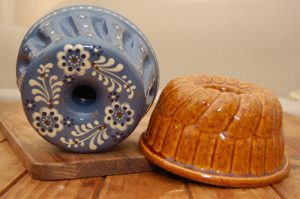

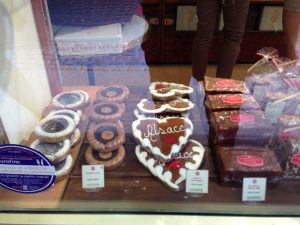
From Paris, It’s easy to get to Strasbourg, the capital of Alsace. Those of us who endured the five hour plus ride in the olden days are grateful for the sleek fast trains (French and German) that barrel along at more than 300 kilometres per hour, reducing total trip time to a mere hour and a half.
Strasbourg’s main attraction is the immense, one-spired eleventh century Gothic Notre-Dame Cathedral and its astronomical clock. Fashioned from sandstone, the cathedral takes on different hues, from grey to pink to almost red, depending on the season and the hour of the day. A friend and I, sitting in front of it at a nearby café savouring a flammekeuche (kind of an Alsatian pizza with cream and munster and bacon on the top), concluded that we could happily remain there all day just to watch the pageant of changing colors.
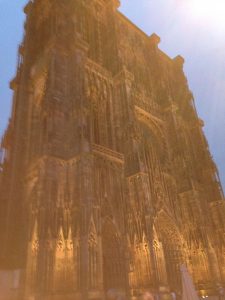
Strasbourg has scores of half-timbered houses, narrow streets, charming canals and a lovely Old City. But it is also the well-kept up modern home of several European institutions including the European Court of Human Rights and, with Brussels, the European Parliament which holds 12 sessions a year of four days each. And as everywhere else in Alsace, Strasbourg’s streets are clean – and such a contrast to the litter-strewn ones of Paris.
South of Strasbourg is the well-known and much travelled “route du vin” which features village after village of colourful houses, storks on their high posts, places to taste – and buy – the wonderful wines of Alsace (Riesling, Gewurztraminer, Muscat, Pinot Noir).
Riquewihr, a wine-making town of 2000 inhabitants (and easily ten times that of tourists), is the jewel in the crown. You are literally stunned as you wander down the cobblestoned streets gawking at the medieval half-timbered houses painted in what some might consider outlandish or garish tones – that somehow work.
To be sure, there are softer hues, such as this green house I love
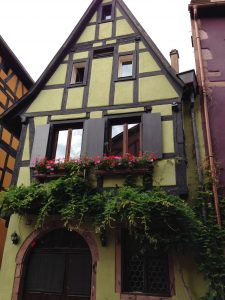
But then we move on to bolder colours, such as this blue and yellow duo side-by-side
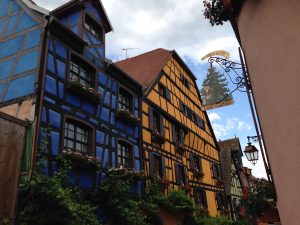
I thought that was probably the height of daring color combinations but saw I was wrong when I came upon the gem below which conjured up images of gingerbread houses, witches, black cats and cobwebs.
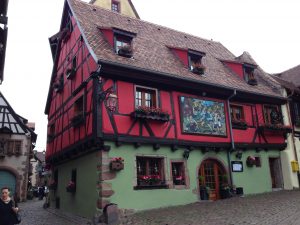
We could barely tear ourselves away from Riquewihr to our final destination: the town of Colmar and its world-famous Unterlinden Museum. Located in a former 13th century convent, the museum houses the magnificent and moving 16th century Isenheim Altarpiece by Matthias Grunewald. He painted this tableau of the Crucifixion for sufferers of the plague in the nearby monastery of St. Anthony; its powerful message still resonates today.
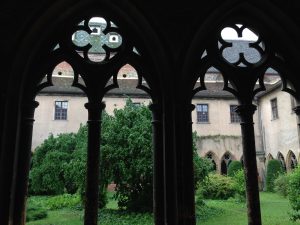

Alsace is a feast in so many ways, in the taste of its traditional food, in the architecture of its houses and churches, in the tranquility of its villages and vineyards. No wonder Germany coveted it, occupying Alsace from 1870 to 1918 and annexing it in World War II and forcing Alsatian men to enrol in the German Army – they were called “malgré-nous” (in spite of ourselves). The Alsatian artist Jean-Jacques Waltz, better known as “Uncle Hansi”, illustrated books showing typically dressed Alsatian children in a pro-French happy Alsace. (note the French flag planted in the soil of the vase with the cardboard cutout of an Alsatian boy). Hansi was captured by the Gestapo in 1941 and beaten so badly he was left for dead. (He survived and died after the war in Colmar).
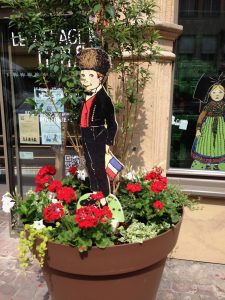
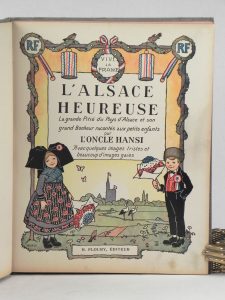
The Alsatians speak a German dialect, but don’t think (or tell them) they’re speaking German. That’s an insult. They are fiercely proud of their region, fiercely proud to be Alsatian. They even refer to the French people who don’t live in Alsace as “les Français de l’intérieur” (the French of the interior).
I imagine it might be hard to fit into their culture if you aren’t born into it, but it’s not hard at all to take a little trip and admire this thoroughly admirable part of France.
How lucky you were! The museum in Colmar was closed when we were there a few years ago.
Interested in boring blog posts? Try mine.
You must go back to see the museum in Colmar! It is wonderful. I’ll go check out your “boring” blog posts – I’m sure they’re not.
Three years ago we fell in love with Strasbourg and Colmar. We chose not to go on and do the wine route, preferring to spend more time in Strassbourg. We visited Colmar twice during our stay; we loved it so much. and my husband who knew so much about the alter piece was blown away seeing it in person. The cuisine of Alsace is fabulous and the people warm I love the folklore about the storks (and they have lots of stork nests to be seen), the story and tradition behind the metal signs are fascinating to learn. I love all parts of France and feel more at home there than here but I have to admit that Alsace is indeed a magical place, like a step into my childhood memories. Thanks for sharing
I too love Alsace and feel it’s a place for childhood memories -even if it’s not our country or our childhood! There’s something universally appealing about those big, colourful houses, the reassuring food, hey, even the storks! Thanks for your remarks.
I’m one of the lucky friends who got to accompany you on this trip. Your beautiful
descriptions of this glorious and unique area of France reflect my feelings exactly.
Alsace is a truely a special and not so well known gem!!
Thanks, Betty
Loved sharing one of our favourite places with you and Ron!
Nice report. However, there was something missing: the houses of Alsace, some say, do look more German than French.
That is not without reason: after all, Alsace was German from the year 870 (no, not 1870) all the way to the 17th century, when France conquered the region from the Holy Roman Empire of the German Nation.
There had been attempts by France since 876 to expand at the expense of her Eastern neighbour. Those moves came to a temporary halt in the Hundred Year’s war, but continued in the 16th century with ever-increasing strength, reaching a pinnacle in the later 17th and 18th centuries (burning of the Palatinate, anyone? Of course, no Frenchman would avow that anything such a thing happened – as a German, I know the French and their proclivity for seeing only their own view only too well).
And so, our old realm, the Holy Roman Empire of the German Nation, which had existed since 962 without interruption, became weaker and weaker and was crushed ultimately in 1806 under the weight of yet another French aggressor – Napoleon.
In 1870, after yet another French aggression against Germany, she reunited at last and regained Alsace and a part of Lorraine in order to have a buffer against the perennial attacker in the West. Meanwhile, though, many middle-class Alsatians had begun to feel an attachment to the French culture and nation (the Alsatian farmers and artisans, not so much) in the two centuries since the French conquest. Consequently, the Alsatians were pulled back and forth until 1945, when, thanks to Satan’s deputy on earth on Earth, i.e. H.tler, the French ultimately won.
If I were French or British or American, I would thank the Lord every day for H.tler’s existence, for I would have been given a wonderful pretext to be racist against Germans and despise German culture. This situation has not improved one iota in the decades since he at last went to Hell.
I know the French very well in this regard, and Hansi, the painter of (more or less) mawkish postcards, was a dyed-in-the-wool racist himself. He maintained sometime in the 1920s that Germans were not human, but swine. Well, the good man also was a rabid anti-Semite; try to get an uncensored book of his caricatures from the 1930s (published in France) if you can. Read it and weep at his gross misrepresentations of Jewish people. At least, I know one Alsatian who is ashamed of Hansi and his attitude, so there is hope.
And the poison he spewed forth obviously is not yet gone: on 11th of November this year, somebody flew a pennant in the Alsatian colours (red and white) from the tower of Straßburg Cathedral, in memory of the centenary of the declaration of the “Free State of Alsace-Lorraine”, which existed for eleven days, until the French Army marched in. Rather harmless (and it was taken down quickly), but some Germanophobic French sow (sorry) was not ashamed to comment on this as a display of “Nazi sympathy” if you can believe it – as if they had existed in 1918! 🙁
I could write much more, but to cut a long story short: to my eyes, these occurrences are just the tip of the iceberg, and I reserve the right to consider France untrustworthy. The legacy of eleven centuries of enmity will not go away anytime soon, and the French and us being as different as fire and water makes getting along still more difficult.
Just a slightly different perspective from a German 🙂
But thank you for your words and photos, nonetheless 🙂
Indeed, this is another perspective on Alsace. Thank you.